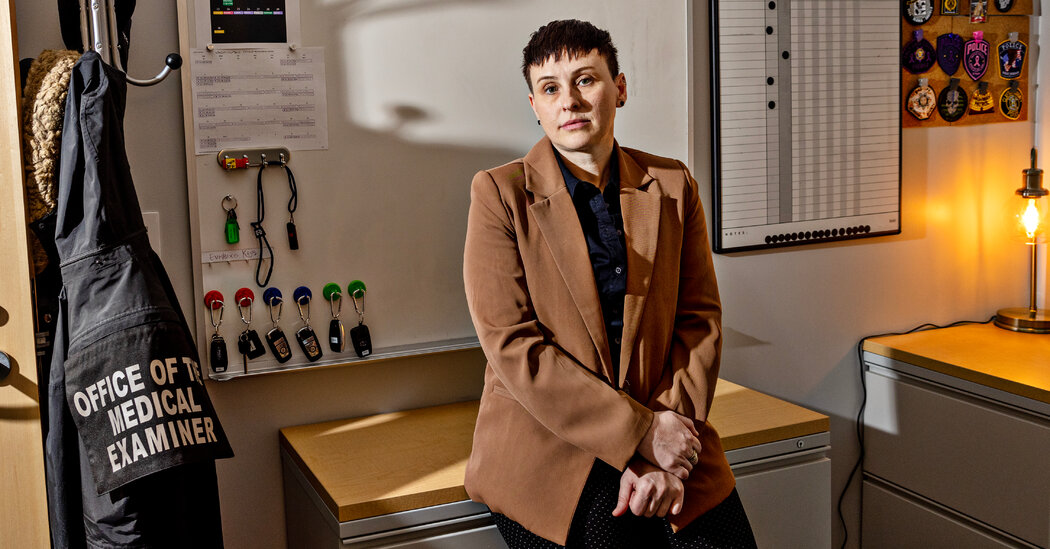Moving Is a Monumental Task for Many Older Americans. These Organizers Can Help.
The four-bedroom house that Ray and Beth Nygren had lived in for 20 years in Auburn, Wash., measured about 2,400 square feet. The two-bedroom apartment that awaited them in a nearby independent- and assisted-living complex was less than half that size.
They were moving — “maybe a little reluctantly,” said their daughter, Bonnie Rae Nygren — because each had undergone heart-valve replacement surgery last year, and Beth Nygren had suffered complications. The single step from living room to dining room, or down to the family room, had become difficult for her to manage using a walker.
She’d already taken a fall. “They considered it a very minor thing, but it was really eye-opening for us,” said Bonnie Rae. “One more fall could make a huge difference in their lives.”
The couple’s three children suggested that with Beth, 85, coping with multiple sclerosis and Ray, 87, contending with heart failure, “maybe it was time to downsize and move to a retirement community,” Bonnie Rae said.
Earlier this year, the family began sorting through 65 years of possessions. “Digging in, we realized how much stuff they had,” Ms. Nygren recalled. “How many towels do you need? What dishes do you want to take? What pictures do you want on the walls? And, what about the things you can’t take?” The process felt overwhelming.
The family had never heard of senior move managers until the retirement facility recommended a few, including RR Move Co.
The elder Nygrens almost balked when owner Rebecca Ricards walked through their house, talked with them about their concerns, took lots of photos — and quoted a price of $5,400 for planning the move, packing their belongings and setting up the new residence, including the moving van and movers.
But reassured by her experience and confidence, they hired her, with their son contributing a chunk of the costs.
About 1,100 such companies belong to the National Association of Senior & Specialty Move Managers, which offers training and certification, and requires members to carry liability insurance and adhere to a code of ethics.
Depending on the needs of clients, move managers’ services include sorting and organizing belongings, working with a moving company and using a floor plan to determine what can fit where in the new residence.
They prepare the new home, from spices in the cabinets to towels on the racks; they can sell, donate or dispose of what’s left behind. Though Ms. Ricards charges by the job, most move managers charge $65 to $125 an hour, with big regional variations, said Mary Kay Buysse, the association’s co-executive director.
That’s not within everyone’s means, but most clients are moving into private-pay senior living facilities, often after selling a house, and can afford the additional expense. Clients with smaller budgets may be able to purchase some services, not the whole package. Family members may also help shoulder the costs.
“It’s not just packing and unpacking,” Ms. Buysse said. “It’s working with the clients and the family for weeks or months, going through a lifetime of possessions. You need to be a good listener.”
Older people relocate far less frequently than younger ones. A Census Bureau report in 2022 found that from 2015 to 2019, about 6.2 percent of the population over age 65 had moved in a given year, compared with about 15 percent of the younger population. Still, senior migration topped three million adults a year. The rate increased among those over age 85 and those with a disability.
The most common reasons for moving? Living closer to family members topped the list, especially among those 75 and older, according to a survey published in the Journal of the American Planning Association last year. Respondents also cited better neighborhoods and reduced housing costs.
Though senior move managers often work with adult children to help move their parents, the industry is seeing an uptick in younger seniors hiring managers for themselves, Ms. Buysse added.
A New York native, Alissa Ballot had already downsized from a house in Florida to a Chicago apartment when, in 2021, she decided “it was time to move home.” But selling her place in Chicago while finding an apartment in New York during the pandemic became “nervous breakdown time,” said Ms. Ballot, 67, a retired lawyer. “There were all these balls up in the air — a few balls too many.”
Dawson Relocation Services in Chicago charged her less than $1,000 (at $65 an hour) to coordinate the move. “I was able to set a date to get on a plane with a few suitcases and leave everything else to them,” Ms. Ballot said. “It was a miracle.”
She unpacked on her own, but she didn’t have to return to clean out and close up her Chicago apartment. Marnie Dawson even helped her file claims when the movers dinged a couple of Ms. Ballot’s possessions.
(Besides senior move managers, older movers may encounter real estate agents, attorneys, senior living staff and others who are “certified relocation and transition specialists.” About 1,000 individuals have passed this credentialing exam, said Donna Surges Tatum, chair of the Certified Relocation & Transition Specialist Certification Board. The National Association of Realtors also designates “senior real estate specialists.”)
Relocating older adults involves particular challenges. Unlike younger movers, they’re generally shifting into smaller, not larger, spaces — after decades more time to accumulate stuff. And their families, for better or worse, are often involved.
A move manager has to be a social worker in part. “We’re sometimes dealing with people with cognitive issues. Family dynamics come into play,” said Diane Bjorkman, whose company serving the Twin Cities, Gentle Transitions, is the country’s oldest and probably largest senior move management company.
A nonjudgmental professional can often calm tensions. “It’s not you telling your mom, ‘Don’t take the torn recliner,’” Ms. Bjorkman said. “It’s someone else saying, ‘Maybe another chair would work better.’”
My sister and I hired a senior move manager for our father, who was moving into an independent living apartment, when it became clear that discussing matters like precisely how many identical plastic flashlights he needed could consume months. We deferred to a third party.
Still, in the end, the client decides. One woman who hadn’t cooked for 20 years insisted that she needed to hold on to a particular roasting pan, Ms. Bjorkman recalled. The woman also argued that, as someone who remembered the Depression, a free-standing freezer was a crucial source of comfort — even if it was full of expired food.
The roasting pan could be disassembled to fit under the bed in the new apartment, Ms. Bjorkman said. The freezer — still packed with food — served as a living room side table.
The Nygrens made no such unusual requests. Their children handled the weeks of sorting and paring, and Ray Nygren — a retired engineer — drew detailed schematics of the new apartment, showing where items should go.
RR Move Co. did the rest, packing one day in March and moving them into their new apartment the next. At about 6 p.m., Ms. Ricards and her crew phoned the family to say they were ready for what she calls “the big reveal.”
“We walked in, and it was like walking into your home,” Beth Nygren said, getting weepy on the phone. There were no boxes in sight. The move managers had made the beds, set the clocks, made sure Ray’s computer was operational.
“Everything was in place: clothes in the closet, pictures on the wall, stuff in the drawers,” Ms. Nygren said. “You could just start living.”


